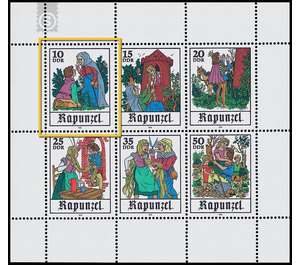Commemorative stamp series - Germany / German Democratic Republic 1978 - 10 Pfennig
Theme: Mythology
| Country | Germany / German Democratic Republic |
| Issue Date | 1978 |
| Face Value | 10.00 |
| Color | multi-colored |
| Perforation | K 13:13 1/2 |
| Printing Type | offset |
| Stamp Type | Postage stamp |
| Item Type | Stamp |
| Chronological Issue Number | 2124 |
| Chronological Chapter | GER-DDR |
| SID | 933301 |
| In 17 Wishlists | |
Märchen-Kleinbogen, Edition 1978 With motifs from the fairy tale "Rapunzel", the Ministry of Posts and Telecommunications of the German Democratic Republic publishes six multicolored special postage stamps. The six postage stamps are printed together on a miniature sheet. Special cancellation from 21st November 1978 to 20th January 1979 No special First Day Cover Cover Rapunzel One of the most famous fairy tales of the Brothers Grimm is "Rapunzel". It tells the story of a girl of adolescent age and a jealous stepmother who does not want her to gain independence. The Adolessenzproblem finds a happy solution by the union of Rapunzel with the king's son. The fairy tale "Rapunzel" is an interesting example of the transformation and transformation of a folk tale, which has long lived in the people, was used by writers for their own work and has been redecorated by the Brothers Grimm back. The Brothers Grimm have eavesdropped their fairy tales on the lips of the people. But not all fairy tales were recorded after oral narration. In the literature of the 16.-18.Jahrhunderts they came across stories, behind which they suspected a real folktale. They liberated them from the literary embellishment and adapted them in the style of stories from an oral source, thus turning them back into a folktale. In the "Small Novels" by Friedrich Schulz (1762-1798), published in 1790, the Grimm brothers found the story "Rapunzel", which they described as "too broadly narrated, as no doubt derived from oral legend". Friedrich Schulz offers only a clever and embellished by their own ideas translation of the fairy tale "Persinette" of the Mlle de la Force (about 1654-1724), whose fairy tales were published in 1698. What the Brothers Grimm did not know, for Friedrich Schulz did not conceal his source. Mlle de la Force in turn claimed to have invented the story freely, which can not be true. In the Mediterranean area numerous stories are common, which coincide in content with the fairy tale "Persinette", which are all recorded from oral tradition. So also in the "Pentameron" of Basil (1575 to 1632) contained fairy tale "Pentrosinella". Mlle de la Force has therefore edited and decorated a French folk tale. She herself invented the final part, the punishment and redemption of the two lovers. Wilhelm Schulz has added the window hook and the too tight dresses. The Brothers Grimm have taken over this. For the second edition Wilhelm Grimm changed the fairy tale again. Not only did he fill it up a bit, he also needed to change details for pedagogical reasons. Contemporary reviewers had taken offense that Rapunzel betrayed her pregnancy with the words "my clothes are too tight and do not want to fit anymore". As of the second edition of 1819, this decisive scene is changed and Rapunzel now asks "Tell me, Mrs. Gothel, how is it that she will be much more difficult to bring up than the young king's son, who will be with me in a moment." Content: A couple, looking forward to the birth of a child, lived next to a magnificent garden, with Rapunzeln. The woman was so hungry that she thought she would die if she did not get it. Her husband secretly climbed into the garden and fetched Rapunzeln. When he wanted to get some again, he was surprised by the sorceress. The man told her about his plight, and she allowed him to take as many Rapunzels as he wanted on the condition that he hand over to her the child who is going to give birth to his wife (10-pfennig value).


